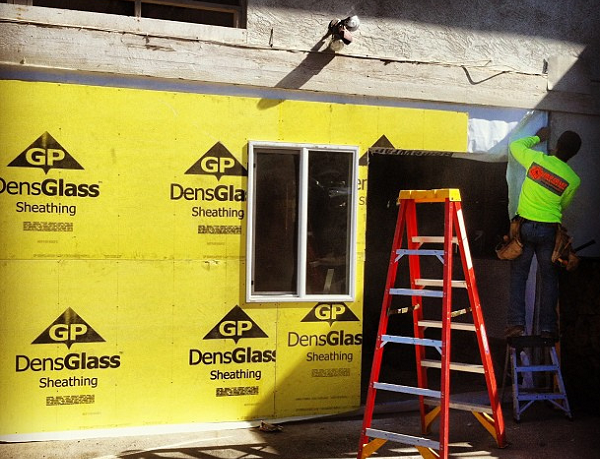 The Department of Commerce announced Tuesday that housing construction has risen 22 percent since January. Similarly, the number of building permit applications have skyrocketed and experts expect continued gains through the duration of 2014. Realtors also have reason to celebrate as housing starts were reported up nearly 22 percent since last July.
The Department of Commerce announced Tuesday that housing construction has risen 22 percent since January. Similarly, the number of building permit applications have skyrocketed and experts expect continued gains through the duration of 2014. Realtors also have reason to celebrate as housing starts were reported up nearly 22 percent since last July.
But it is no coincidence that the construction and real estate industries have seen substantial growth. Both industries have considerable stakes in ensuring the current immigration debate that plagues Congress results in their advantage.
That the housing sector seems to be doing much better is not some random occurrence. Rather, it is a result of the 1 million legal immigrants entering the country every year and 12 million illegal immigrants currently residing in the U.S. It is the effect of home insurance organizations, utility companies and others whose business models are based on endless population growth at the cost of America’s best interests.
They have devoted $42 million thus far this year toward lobbying Washington’s lawmakers to pass immigration reform laws that would grow the population and in turn create a higher demand for housing properties and greater competition among blue-collar employees looking for work.
The National Association of Realtors is currently the second highest spending national lobbyist. Realty special interest groups or housing-related organizations who seek special legal advantages, want lawmakers to introduce bills that will positively affect their clients’ business interests and they are very motivated to do so. These groups are bigtime advocates for extending DACA to more illegal aliens and giving permission for unauthorized immigrants to work but none of these programs are intended to benefit Americans.





14 Comments
Does anyone really believe there’s 12 million illegals in the U.S.? Bush said there was 12 million in 2007. The Reagan/Kennedy amnesty in 1986 put the number at 1.3 million. After all was said and done it turned out to be 3.5 million. I’m betting the number now would be closer to 30+ million.
Do you think the Perry home builders and the Toll family of home builders want E-verification? It’s time for Texas voters to dump Gov. Rick and those who are blocking e-verify. Kick them out! Expose the companies hiring the illegals. Quit supporting GOP congressmen who make it possible to bring in nurses,etc. on visas to lower pay. Give Dems the message if they want fair boundaries, rather than back door deals a la MR. DeLay’s gerrymandering, they should represent Texans before immigrants.
When living in Texas our neighborhood was only allowed to water on certain days of the week. Later that was changed to also include, just certain times of the day. That was 4 years before this massive surge of illegal immigrants came in. Whether the water shortage was created from overbuilding, lack of rain, hydraulic fracturing- “fracking”, or massive illegal immigration, why would the Cities, much less the State, allow this overbuilding to continue when there is not enough water?
Texas’s Lake Travis northwest of Austin is 40 FEET below the conservation level. That equates to BILLIONS of gallons of water. Over the last 7-8 years there have been atleast 10,000 new houses and apartments built along the lake. Not to mention the thousands and thousands of houses and apartments elsewhere in the state. Here is the simple reality as I see it. In many areas we are not really in a drought condition. Instead, demand on our lakes and rivers has outstripped the natural recharge capability of a typical year’s rainfall. I think the annual amount of rain has actually remained within the normal range of year to year variation. What has changed is that demand has risen beyond nature’s ability to replace the water consumed, due to much higher demand. I do not have the hard scientific data to support my conclusion. It is based upon a casual tracking of the weather patterns over the last over the 20 years here in Texas.
I think it is past time to start investing in desalination plants. Actually we should have started building them 20 years ago.
And we need to seriously begin to look at building moratoria. Developers and State and Local governments have had an unholy alliance for generations. Cities annex adjoining lands, build new sewer and power infrastructure, new roads etc. using the current residents’ tax money. City gets more tax money, developers get more money, and we get crowding, traffic, and diminished quality of life. We need to stop annexation. If a developer wants to build more than 25-50 new houses, let them go out and buy land set up and incorporate as a new City/Town, and pay for their own new water, infrastructure, power etc. No more free rides on the local population’s back.
In the future, the lever the gov will use to get their way will be water. Face it, they control it now (ever try to get a well permit, why should a citizen even have to get gov approval for a well on one’s own property?) Anyone have an alternative to water?
I Agree With Your Opinions
San Antonio Texas rates the worst water drought city in America:
“…Look at the revolution in Texas energy production due to unconventional drilling techniques — new approaches that have changed the oil patch almost beyond recognition. Where’s our revolution in water technology?
A new study from my office, “Texas Water Report: Going Deeper for the Solution,” examines some of the wide-ranging implications of water shortages, including the intricacies of “water politics” between states and nations, and proposes solutions that can help us ensure that clean water keeps flowing to our farmers and ranchers, our power plants, cities and industries.
Many of America’s fastest-growing metro areas are located in water-threatened regions. And Texas in particular has much to lose.
According to the reports they provide to the Texas Commission on Environmental Quality, as of Jan. 8, 29 Texas municipal water systems were in danger of running out of water within three months. Two small communities, Spicewood Beach and Barnhart, have run dry entirely.
If something similar happened to one of our metro areas, the economic damage could be catastrophic, and a University of Florida study ranked San Antonio as the nation’s most water-vulnerable city.
Of course, many are grappling with our water problems right now, pioneering new techniques and technologies that can stretch existing water and open up new supplies. The Texas Water Report profiles a number of promising new approaches, including strategies such as water reuse and aquifer storage and recovery. We also examine the rapidly evolving field of desalination, which could allow us to use the ocean of brackish water contained in Texas aquifers.
Nonetheless, much of Texas’ planned spending on water is still devoted to traditional approaches —additional reservoirs, stream diversions, water pipelines and conventional conservation methods. They’re all worthwhile, but we’re going to need new solutions as well…”
http://jacobswellspringnews.blogspot.com/2014/01/texas-water.html
What About California too, as they bulldoze the citrus trees down that are dead from lack of water?
“…He added that this reaches far more than just his farm, that the drought permeates all aspects of the industry, not just growers.
Stevenson predicted that this coming season, he’ll produce and deliver to the packing house about 25 percent of the volume of citrus produced in the past year. “That impacts not only our employees but the packers at the packing house, the people who sell the fruit, and the people we buy pesticides and fertilizers from,” Stevenson added.
With drought reaching the majority of the state, with 58 percent of California at the highest drought-level, according to a U.S. Drought Monitor report, some farmers are thinking about the future of the industry in California.
“Now, I understand not all of Fresno and not all of California looks this bad, but imagine that we’re like the “canary in the coal mine”. This is what the future of California looks like. This kind of devastation that you see here is what our future looks like. If we continue to have no or little surface water deliveries, and as the groundwater situation continues to deteriorate. Without more surface water, without more water supplies, this is the future of the Central Valley,” said Stevenson….”
http://watchdogwire.com/california/2014/08/04/harlan-ranch-bulldozes-trees-due-to-lack-of-water/
How about desaltination of sea water to help?
“….The graph to the side from Yale University in 2012 suggests that such energy consumption is as low as 2 kWh per cubic metre. But this is still considerably higher than the 0.2 kWh per cubic metre, or even less, required for local fresh water supplies….”
Even with the most efficient new technology, multiply your current water bill by about 10. If you’re now paying about a $100/month for water….it becomes a $1000/mo bill for the same amount of water with the best technology available…
http://www.water-challenge.com/post/2014/02/19/Seawater-desalination-%e2%80%93-a-solution-to-reduce-water-shortage.aspx
Nope, without immediate depopualtion, America is on a road to ruin…..just on the water problem alone….
.
A lot of people promote desalinization as the solution, but the fact is it’s much more expensive and higher in energy usage. Plus how about the infrastructure that would be required to move the water from the ocean to interior areas which can be many hundreds of miles away.
So you want building moratoriums but no moratorium on immigration? How does that help if we have a growing population? It’ doesn’t, it simply makes housing more expensive for the people who earn the least. Is there a point at which you might say enough people? When would that point be?
Over Building Real Estate Bubbles
Is not good for the economy either….the lower paid immigrants brought in to replace legal citizen and Millenial jobs for less pay may cause some “short-term” marginally qualified home sales…..but like the last 2007 housing bubble, the price collapse due to over building and reposessions that occurs soon after the sales, makes all our neighborhoods turn into destroyed Detroits.
There was a report released today that said groundwater supplies in the west have been lowered by 63 trillion gallons in the last year. A city in New Mexico is considering a plan that would pay farmers not to grow crops and the city would use that water. There is not enough water for humans, business, and agriculture. But don’t dare suggest we restrict immigration which would stabilize our population and enable us to stretch our supplies. No, instead you get called a nativist if you propose that. The Sierra Club will say it’s the “greening of hate”.
Ha!…would stabilize the population and then perish completely in the next 50/to 100 years……most people r old an r not having kids but dogs and cats…….
You can keep pretending, for whatever reason you are doing it, but we have do not have the water supplies to keep up with the population we have now. If we need more immigrants a hundred years from now, that would be the time to address it. For now, it’s the last thing we need.
If I’m not wrong, the problem with water allocation isn’t that there “isn’t enough of it”, but that the rates we pay for water usage are in large part set by government. This causes water to be misused for uses that aren’t very valuable.
The west is in the middle of a 14 year drought. In an area that to begin with has always gotten very little rain. Keep on dreaming that unlimited numbers of people can move here and it won’t have an effect on how much water is available. What’s your solution? Double water rates?
Leland you just got a lesson from M. Tontchev probably either an intelligent immigrantt or son of an immigrant….that is the kind of people we need NOT youwho is still stuck on obsolete fixed ideas……you do not even grasp the concept or progess vs population vs age demographics VS FUTURE…….
It does not matter at the end……whatever happens will happen….